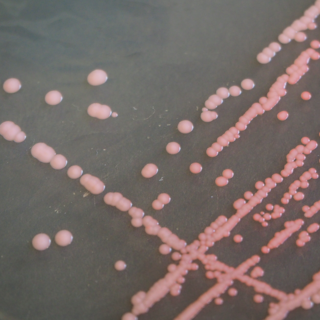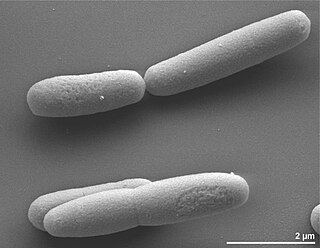Related Research Articles

Sulfur-reducing bacteria are microorganisms able to reduce elemental sulfur (S0) to hydrogen sulfide (H2S). These microbes use inorganic sulfur compounds as electron acceptors to sustain several activities such as respiration, conserving energy and growth, in absence of oxygen. The final product of these processes, sulfide, has a considerable influence on the chemistry of the environment and, in addition, is used as electron donor for a large variety of microbial metabolisms. Several types of bacteria and many non-methanogenic archaea can reduce sulfur. Microbial sulfur reduction was already shown in early studies, which highlighted the first proof of S0 reduction in a vibrioid bacterium from mud, with sulfur as electron acceptor and H
2 as electron donor. The first pure cultured species of sulfur-reducing bacteria, Desulfuromonas acetoxidans, was discovered in 1976 and described by Pfennig Norbert and Biebel Hanno as an anaerobic sulfur-reducing and acetate-oxidizing bacterium, not able to reduce sulfate. Only few taxa are true sulfur-reducing bacteria, using sulfur reduction as the only or main catabolic reaction. Normally, they couple this reaction with the oxidation of acetate, succinate or other organic compounds. In general, sulfate-reducing bacteria are able to use both sulfate and elemental sulfur as electron acceptors. Thanks to its abundancy and thermodynamic stability, sulfate is the most studied electron acceptor for anaerobic respiration that involves sulfur compounds. Elemental sulfur, however, is very abundant and important, especially in deep-sea hydrothermal vents, hot springs and other extreme environments, making its isolation more difficult. Some bacteria – such as Proteus, Campylobacter, Pseudomonas and Salmonella – have the ability to reduce sulfur, but can also use oxygen and other terminal electron acceptors.
Chromohalobacter beijerinckii is a motile, rod-like, salt-loving, Gram-negative soil bacterium, 0.4–0.6 μm by 1.8–2.5 μm.
Afifella is a genus in the phylum Pseudomonadota (Bacteria). Afifella are found in marine and estuarine settings, including microbial mats. They are anaerobes, with one cultured representative capable of photosynthesis.

The genus Alishewanella is one of the major branches of the family Alteromonadaceae. It was proposed to accommodate A. fetalis, isolated from an autopsy of a human fetus, in 2000. In 2009, A. aestuarii was isolated from tidal flat sediment and indicated as being a representative of Alishewanella. The third Alishewanella species was isolated from gajami sikhae, a Korean fermented food, in 2009 and was given the name A. jeotgali. Most recently, in 2010, the fourth currently isolated species of Alishewanella, A. agri, was isolated from landfill soil in Korea. Currently these are the only four isolated and characterized species of the genus Alishewanella.
Armatimonas rosea is a Gram-negative bacterium and also the first species to be characterized within the phylum Armatimonadota. The Armatimonadota were previously known as candidate phylum OP10. OP10 was composed solely of environmental 16S rRNA gene clone sequences prior to A. rosea's discovery.
Chthonomonas calidirosea is a Gram-negative bacterium and also the first representative of the new class Chthonomonadetes within the phylum Armatimonadota. The Armatimonadota were previously known as candidate phylum OP10. OP10 was composed solely of environmental 16S rRNA gene clone sequences prior to C. calidirosea's relative, Armatimonas rosea's discovery. It is now known that bacterial communities from geothermal environments, are generally constituted by, at least 5–10% of bacteria belonging to Armatimonadota.
Fimbriimonas ginsengisoli is a Gram-negative bacterium and the first representative of the class Fimbriimonadia within the phylum Armatimonadota. The Armatimonadota were previously known as candidate phylum OP10. OP10 was composed solely of environmental 16S rRNA gene clone sequences prior to F. ginsengisoli's relative, Armatimonas rosea's discovery.
Persephonella marina is a Gram-negative, rod shaped bacteria that is a member of the Aquificota phylum. Stemming from Greek, the name Persephonella is based upon the mythological goddess Persephone. Marina stems from a Latin origin, meaning "belonging to the sea". It is a thermophile with an obligate chemolithoautotrophic metabolism. Growth of P. marina can occur in pairs or individually, but is rarely seen aggregating in large groups. The organism resides on sulfidic chimneys in the deep ocean and has never been documented as a pathogen.
Marinitoga piezophila is a species of rod-shaped, thermo-piezophilic bacteria. It is, anaerobic, chemo-organotrophic, sulfur-reducing, motile, have a mean length of 1-1.5 micrometres and stains Gram-negative. The type strain is KA3T.
Haloferax larsenii is a gram-negative, aerobic, neutrophilic, extremely halophilic archaeon. It was named in honor of Professor Helge Larsen, who pioneered research on halophiles.
Meiothermus timidus is a species of yellow-pigmented Deinococcota bacteria. It was first isolated from the hot spring at São Pedro do Sul, in central Portugal, and at the island of Sao Miguel in the Azores. Its type strain is SPS-243T. The species was differentiated with the 16S rRNA gene sequence and biochemical characteristics.

Rhizopus oryzae is a filamentous heterothallic microfungus that occurs as a saprotroph in soil, dung, and rotting vegetation. This species is very similar to Rhizopus stolonifer, but it can be distinguished by its smaller sporangia and air-dispersed sporangiospores. It differs from R. oligosporus and R. microsporus by its larger columellae and sporangiospores. The many strains of R. oryzae produce a wide range of enzymes such as carbohydrate digesting enzymes and polymers along with a number of organic acids, ethanol and esters giving it useful properties within the food industries, bio-diesel production, and pharmaceutical industries. It is also an opportunistic pathogen of humans causing mucormycosis.
Delftia deserti is a Gram-negative, short rod-shaped, motile bacterium from the genus Delftia, which has been isolated from desert soil in Turpan in China. D. deserti is of the Betaproteobacteria lineage within the Comamonadaceae family.
Halorhabdus utahensis is a halophilic archaeon isolated from the Great Salt Lake in Utah.
Dokdonia is a genus of bacteria in the family Flavobacteriaceae and phylum Bacteroidota.

Deferrisoma camini is a moderately thermophilic and anaerobic bacterium from the genus of Deferrisoma which has been isolated from a deep-sea hydrothermal vent from the Eastern Lau Spreading Centre in the Pacific Ocean.
Halorhodospira neutriphila is a bacterium from the genus of Halorhodospira which has been isolated from a microbial mat from a marine saltern from Rhone Delta in France. The microbial mat forms at the sediment surface and is between 10 and 20 mm thick, below a fine layer (2–3 cm) of gypsum crust. The mat is composed of a red layer of purple bacteria strains below a green layer of cyanobacteria, interspersed with sulfur globules, and occasionally covered by halite deposits. These mat forming microbes live in anoxic muds and sediments and form a benthic mat in a hypersaline lagoon environment where the salinity of the water ranges from 240-320‰ of total salinity. H. neutriphila was isolated from the red layer of the microbial layer and found to be extremely halophilic and well adapted to withstand the extreme saline conditions of their modified marine habitat. The type strain was identified as strain SG 3301T.
Rhodoplanes azumiensis is a thermotolerant bacterium isolated from sediment mud and cyanobacterial mats located in Nakanoyu hot springs, located in the Azumi district, Matsumoto, Nagano Prefecture, Japan. R. azumiensis is a photoheterotroph that is capable of using many organic materials as its carbon source. Colonies and liquid cultures exhibit a brownish red color when grown phototrophically, and are colorless when grown aerobically in darkness.

Arthrobacter bussei is a pink-coloured, aerobic, coccus-shaped, Gram-stain-positive, oxidase-positive and catalase-positive bacterium isolated from cheese made of cow's milk. A. bussei is non-motile and does not form spores. Rod–coccus life cycle is not observed. Cells are 1.1–1.5 μm in diameter. On trypticase soy agar it forms pink-coloured, raised and round colonies, which are 1.0 mm in diameter after 5 days at 30 °C The genome of the strain A. bussei KR32T has been fully sequenced.

Halanaerobium praevalens is a moderately alkaliphilic, extremely halophilic bacterium that was first isolated from surface sediments of the Great Salt Lake, Utah and described by J.G. Zeikus et al. in 1983, with IJSB validation in 1984.
References
- ↑ Romanenko, Lyudmila A.; Tanaka, Naoto; Svetashev, Vassilii I.; Falsen, Enevold (2013). "Description of Cobetia amphilecti sp. nov., Cobetia litoralis sp. nov. and Cobetia pacifica sp. nov., classification of Halomonas halodurans as a later heterotypic synonym of Cobetia marina and emended descriptions of the genus Cobetia and Cobetia marina". International Journal of Systematic and Evolutionary Microbiology. 63 (Pt 1): 288–297. doi: 10.1099/ijs.0.036863-0 . ISSN 1466-5026. PMID 22427450.